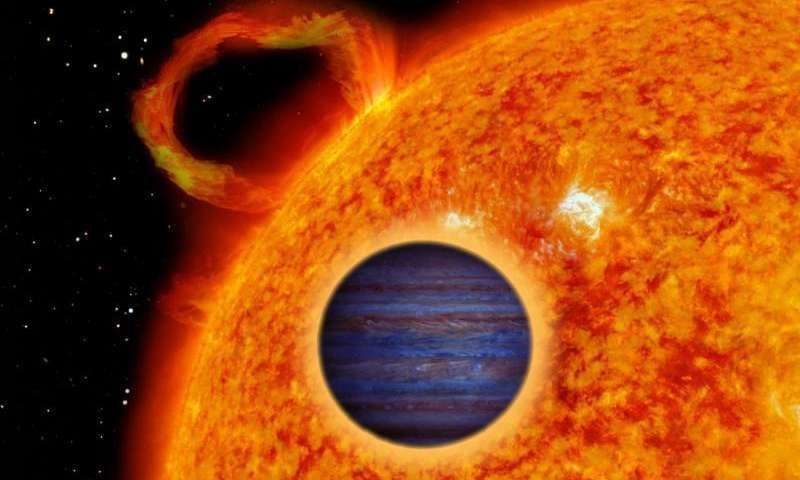February 5, 2018 report
Two new inflated 'hot Jupiters' discovered by astronomers

Astronomers have detected "hot Jupiter" exoplanets transiting two distant stars. The newly found alien worlds, designated EPIC 229426032 b and EPIC 246067459 b, appear to be larger than it should be according to theoretical models. The finding is reported January 24 in a paper published on arXiv.org.
The so-called inflated planets are those that expand in size when their parent stars are at the end of their lives. They have been known to astronomers for almost two decades, but it is still unclear what causes the inflation processes. In general, the possible explanations could be assigned to two theories—scientists believe that the inflation is caused by deposition of energy from the host star, or due to inhibited cooling of the planet.
Now, a team of astronomers led by Maritza Soto of the University of Chile in Santiago, Chile, has identified two new examples of inflated planets that could improve the knowledge about the mechanism behind inflation processes in gas giants. The newly discovered two extrasolar worlds were also classified as "hot Jupiters," as they are similar in characteristics to the solar system's biggest planet, with orbital periods of less than 10 days. They have high surface temperatures as they orbit their parent stars very closely. The inflation process is very often seen in such planets.
The transit signal in the light curves of stars EPIC 229426032 and EPIC 246067459 was detected by NASA's prolonged Kepler mission, known as K2, during its Campaign 11 and 12 (between September 2016 and March 2017). Planetary nature of these signals was later confirmed by follow-up spectroscopic observations.
"We report the discovery of two hot Jupiters orbiting the stars EPIC 229426032 and EPIC 246067459. We used photometry data from Campaign 11 and 12 of the Kepler (K2) Mission, as well as radial velocity data obtained using the HARPS, FEROS, and CORALIE spectrographs," the researchers wrote in the paper.
According to the study, EPIC 229426032 b has a mass of about 1.36 Jupiter masses and is approximately 63 percent larger than our solar system's biggest planet. These values indicate a very low density of EPIC 229426032 b—about 0.38 g/cm3, which suggests that this planet is highly inflated.
EPIC 229426032 b orbits its parent star every 2.18 days, at a distance of 0.036 AU from the host. The planet has an equilibrium temperature of 1,915 K. EPIC 229426032 is a 2.55-billion-year old star of spectral type F6V, about 40 percent larger and 30 percent more massive than the Sun. The system is located some 1,500 light years away from the Earth.
EPIC 246067459 b has a radius of about 1.3 Jupiter radii and a mass of around 0.86 Jupiter masses, which means that its density is approximately 0.56 g/cm3. Although these parameters are consistent with theoretical models for gas giants, the researchers suppose that this planet is also inflated.
"For EPIC 246067459 b, we find its radius to be consistent with the models of Fortney et al. (2007) for a hydrogen and helium dominated planet with no core. This could lead one to believe that this planet is not inflated, which is rare given the fact that the planet receives a high incident flux. The most likely explanation for this, however, is that the planet is enriched in metals (either in the core and/or the envelope), but it is inflated, giving us the impression of a pure H/He-dominated system," the authors noted.
EPIC 246067459 b is located about 0.046 AU from its star, has an equilibrium temperature of 1,587 K and it takes it 3.2 days to fully orbit its host. The parent star is about 60 percent larger and 20 percent more massive than our sun. It is approximately 5.6 billion years old and has a spectral type of G2V. The planetary system is located around 1,480 light years away.
The astronomers underlined the importance of their discovery, noting that the newly found extrasolar worlds could serve as excellent laboratories to study the physics of planetary atmospheres, planetary inflation mechanisms, as well as planet formation and evolution processes.
More information: EPIC229426032 b and EPIC246067459 b: discovery of a highly inflated and a 'regular' pair of transiting hot Jupiters from K2, arXiv:1801.07959 [astro-ph.EP] arxiv.org/abs/1801.07959
Abstract
We report the discovery of two hot Jupiters orbiting the stars EPIC229426032 and EPIC246067459. We used photometry data from Campaign 11 and 12 of the Kepler (K2) Mission, as well as radial velocity data obtained using the HARPS, FEROS, and CORALIE spectrographs. EPIC229426032 b and EPIC246067459 b have masses of 1.36+0.10−0.10 and 0.86+0.13−0.12RJup, radii of 1.63+0.07−0.08 and 1.30+0.15−0.14MJup, and are orbiting their host stars in 2.18 and 3.2 day orbits, respectively. The large radius of EPIC229426032 b leads us to conclude that this corresponds to a highly inflated hot Jupiter. EPIC2460674559 b has a radius consistent with theoretical models, considering the high incident flux falling on the planet. Both of these discoveries represent excellent laboratories to study the physics of planetary atmospheres, and the factors playing a role in planetary infation, as well as planet formation and evolution. EPIC229426032 b is particularly favourable for follow-up studies, since not only is it very inflated, but it also orbits a relatively bright star (V=11.6).
© 2018 Phys.org





















